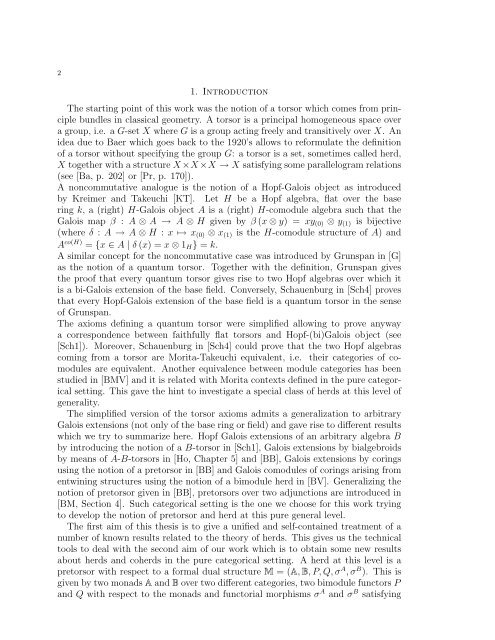Contents 1. Introduction 2 2. Preliminaries 4 2.1. Some results on ...
Contents 1. Introduction 2 2. Preliminaries 4 2.1. Some results on ...
Contents 1. Introduction 2 2. Preliminaries 4 2.1. Some results on ...
Create successful ePaper yourself
Turn your PDF publications into a flip-book with our unique Google optimized e-Paper software.
2<str<strong>on</strong>g>1.</str<strong>on</strong>g> <str<strong>on</strong>g>Introducti<strong>on</strong></str<strong>on</strong>g>The starting point of this work was the noti<strong>on</strong> of a torsor which comes from principlebundles in classical geometry. A torsor is a principal homogeneous space overa group, i.e. a G-set X where G is a group acting freely and transitively over X. Anidea due to Baer which goes back to the 1920’s allows to reformulate the definiti<strong>on</strong>of a torsor without specifying the group G: a torsor is a set, sometimes called herd,X together with a structure X ×X ×X → X satisfying some parallelogram relati<strong>on</strong>s(see [Ba, p. 202] or [Pr, p. 170]).A n<strong>on</strong>commutative analogue is the noti<strong>on</strong> of a Hopf-Galois object as introducedby Kreimer and Takeuchi [KT]. Let H be a Hopf algebra, flat over the basering k, a (right) H-Galois object A is a (right) H-comodule algebra such that theGalois map β : A ⊗ A → A ⊗ H given by β (x ⊗ y) = xy (0) ⊗ y (1) is bijective(where δ : A → A ⊗ H : x ↦→ x (0) ⊗ x (1) is the H-comodule structure of A) andA co(H) = {x ∈ A | δ (x) = x ⊗ 1 H } = k.A similar c<strong>on</strong>cept for the n<strong>on</strong>commutative case was introduced by Grunspan in [G]as the noti<strong>on</strong> of a quantum torsor. Together with the definiti<strong>on</strong>, Grunspan givesthe proof that every quantum torsor gives rise to two Hopf algebras over which itis a bi-Galois extensi<strong>on</strong> of the base field. C<strong>on</strong>versely, Schauenburg in [Sch4] provesthat every Hopf-Galois extensi<strong>on</strong> of the base field is a quantum torsor in the senseof Grunspan.The axioms defining a quantum torsor were simplified allowing to prove anywaya corresp<strong>on</strong>dence between faithfully flat torsors and Hopf-(bi)Galois object (see[Sch1]). Moreover, Schauenburg in [Sch4] could prove that the two Hopf algebrascoming from a torsor are Morita-Takeuchi equivalent, i.e. their categories of comodulesare equivalent. Another equivalence between module categories has beenstudied in [BMV] and it is related with Morita c<strong>on</strong>texts defined in the pure categoricalsetting. This gave the hint to investigate a special class of herds at this level ofgenerality.The simplified versi<strong>on</strong> of the torsor axioms admits a generalizati<strong>on</strong> to arbitraryGalois extensi<strong>on</strong>s (not <strong>on</strong>ly of the base ring or field) and gave rise to different <str<strong>on</strong>g>results</str<strong>on</strong>g>which we try to summarize here. Hopf Galois extensi<strong>on</strong>s of an arbitrary algebra Bby introducing the noti<strong>on</strong> of a B-torsor in [Sch1], Galois extensi<strong>on</strong>s by bialgebroidsby means of A-B-torsors in [Ho, Chapter 5] and [BB], Galois extensi<strong>on</strong>s by coringsusing the noti<strong>on</strong> of a pretorsor in [BB] and Galois comodules of corings arising fromentwining structures using the noti<strong>on</strong> of a bimodule herd in [BV]. Generalizing thenoti<strong>on</strong> of pretorsor given in [BB], pretorsors over two adjuncti<strong>on</strong>s are introduced in[BM, Secti<strong>on</strong> 4]. Such categorical setting is the <strong>on</strong>e we choose for this work tryingto develop the noti<strong>on</strong> of pretorsor and herd at this pure general level.The first aim of this thesis is to give a unified and self-c<strong>on</strong>tained treatment of anumber of known <str<strong>on</strong>g>results</str<strong>on</strong>g> related to the theory of herds. This gives us the technicaltools to deal with the sec<strong>on</strong>d aim of our work which is to obtain some new <str<strong>on</strong>g>results</str<strong>on</strong>g>about herds and coherds in the pure categorical setting. A herd at this level is apretorsor with respect to a formal dual structure M = (A, B, P, Q, σ A , σ B ). This isgiven by two m<strong>on</strong>ads A and B over two different categories, two bimodule functors Pand Q with respect to the m<strong>on</strong>ads and functorial morphisms σ A and σ B satisfying
















